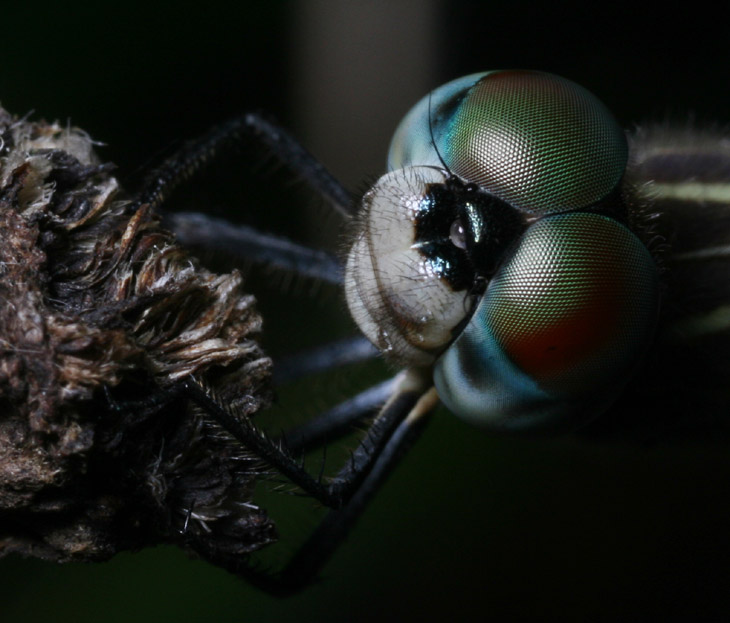
While I have a handful of photos from the past week or so, there isn’t a whole lot to say about them, so I’m mostly just going to throw them up here without a lot of exposition. Right at the moment, I have not identified the dragonfly above, which was hanging around the front garden for a few days being cooperative and photogenic, but I do have to draw attention to the eyes, where there is a difference in density of the ommatidia between the portions that face up and the rest – my best guess is that the top ones (red & green) are only used for detecting threats, while the others (blue) are for homing in on prey and so must have more precision.
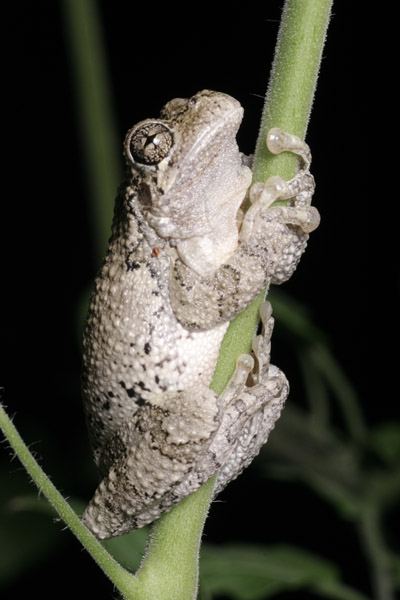 The other night, a Copes grey treefrog (Hyla chrysoscelis) was found clinging to the stem of a cherry tomato plant on the deck, producing a pose that seemed to be evocative of something, but I haven’t pinned down what – perhaps I should hold a caption contest (you might as well send one in – with the dearth of comments you’re pretty much guaranteed to win something.)
The other night, a Copes grey treefrog (Hyla chrysoscelis) was found clinging to the stem of a cherry tomato plant on the deck, producing a pose that seemed to be evocative of something, but I haven’t pinned down what – perhaps I should hold a caption contest (you might as well send one in – with the dearth of comments you’re pretty much guaranteed to win something.)
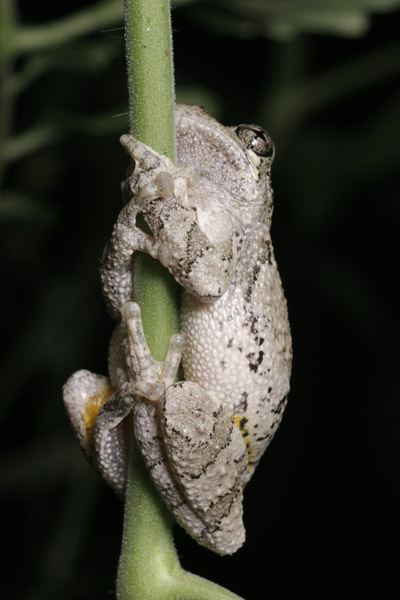 I am identifying this as a Copes grey treefrog, but visually, they are impossible to tell apart from a common grey treefrog; the reason I offer this identification with such supreme and unflagging confidence is that, from the calls that I hear during the rainy nights, this is the only species that seems to be in the area. Copes have a higher-pitched call, possibly from sliding down slippery tomato stems. The underside shot, which I was obligated to obtain, doesn’t have half of the expressiveness of the one above, but shows off the clutching posture much better.
I am identifying this as a Copes grey treefrog, but visually, they are impossible to tell apart from a common grey treefrog; the reason I offer this identification with such supreme and unflagging confidence is that, from the calls that I hear during the rainy nights, this is the only species that seems to be in the area. Copes have a higher-pitched call, possibly from sliding down slippery tomato stems. The underside shot, which I was obligated to obtain, doesn’t have half of the expressiveness of the one above, but shows off the clutching posture much better.
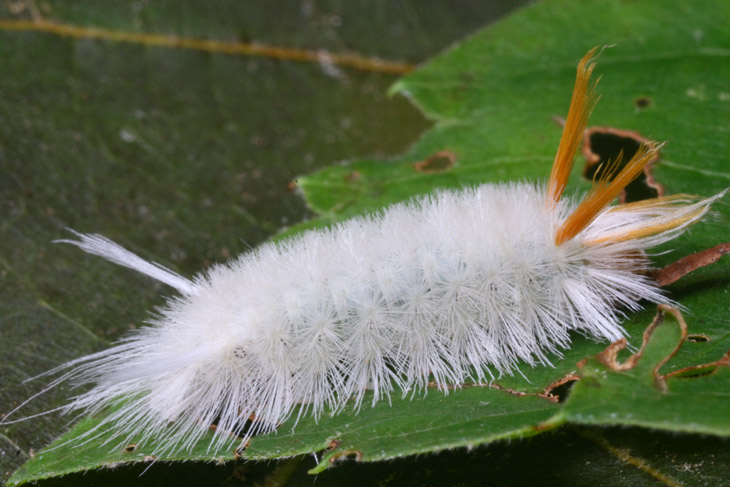
A few weeks back I found a couple of examples of a sycamore tussock moth caterpillar (Halysidota harrisii) and did a short photo session, more from the standpoint of adding to the stock than for anything else, though I suspected it was one of the stinging variety of caterpillars and hoped to be able to photograph the venom spines. I was unsuccessful, perhaps because it is not actually a stinging variety. But while doing this, I did capture a fabulous pose, indicating that this might be a singing variety instead.
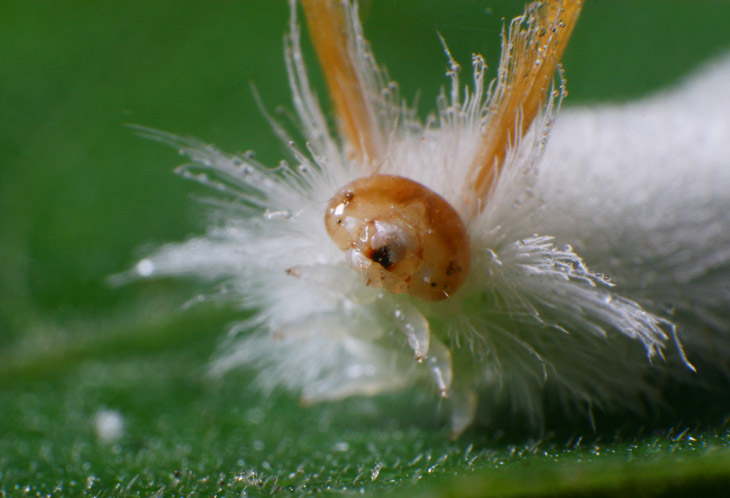
I needed those to lead in to the next, which is the fate of one of the caterpillars, though unlikely one of the ones I photographed.
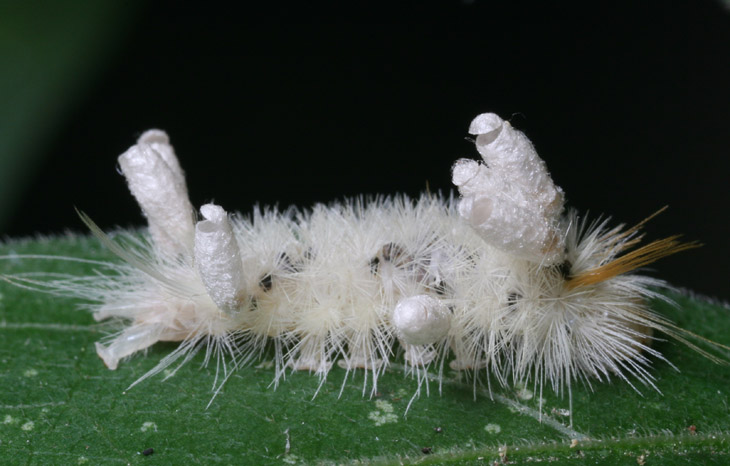
The white Twinkies on its back are evidence of some member of the Ichneumonoidea superfamily, basically braconid wasps, albeit very small ones. More details can be found here, though almost certainly a different species. Long story short: with all of the chrysalises (or chrysalides, whatever plural you like) opened up, this specimen is effectively dead, emptied out from the inside.
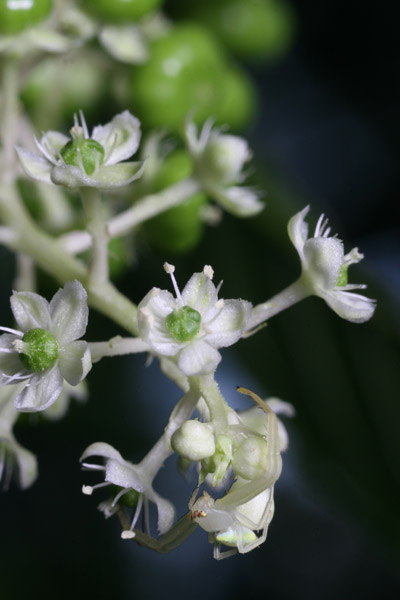 And finally, it’s not a complete week without spiders, so I offer a subtle crab spider hanging out on a pokeweed blossom. This one is considerably larger than last year’s, though still barely noticeable – in fact, well-nigh invisible unless you’re specifically looking. The pokeweed has been just about the only thing blossoming in the yard that could attract the crab spiders, which is a shame because I happen to like them – I’m going to have to plant some prime flower species for them next year, generally white or yellow blossoms that they can camouflage themselves within. The pokeweed flowers are very short-lived, and what happens to the spiders after the flowers become berries, I have no idea. No, that’s not true, because I’ve seen them ballooning across the yard to different hunting grounds, and even intersected one in mid-trip last week. The area plays home to crepe myrtle trees, which come into bloom at this time of year and sport white flowers (as well as purple,) so I imagine they have plenty of feeding opportunities once they alight on the right perch. Maybe I’ll have to go examine some of those flowers closely…
And finally, it’s not a complete week without spiders, so I offer a subtle crab spider hanging out on a pokeweed blossom. This one is considerably larger than last year’s, though still barely noticeable – in fact, well-nigh invisible unless you’re specifically looking. The pokeweed has been just about the only thing blossoming in the yard that could attract the crab spiders, which is a shame because I happen to like them – I’m going to have to plant some prime flower species for them next year, generally white or yellow blossoms that they can camouflage themselves within. The pokeweed flowers are very short-lived, and what happens to the spiders after the flowers become berries, I have no idea. No, that’s not true, because I’ve seen them ballooning across the yard to different hunting grounds, and even intersected one in mid-trip last week. The area plays home to crepe myrtle trees, which come into bloom at this time of year and sport white flowers (as well as purple,) so I imagine they have plenty of feeding opportunities once they alight on the right perch. Maybe I’ll have to go examine some of those flowers closely…



















































